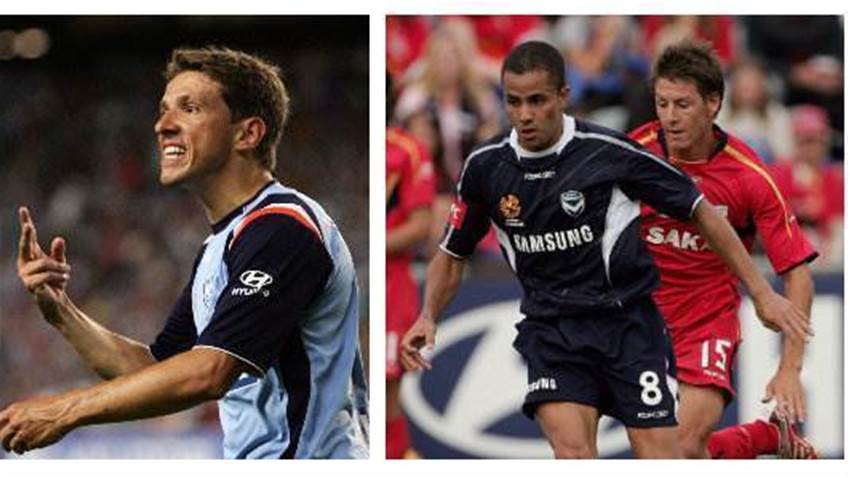Fred; Cassio; Reinaldo; Juninho. The A-League has witnessed a wave of Brazilian talent over 13 years.
But times have changed and now there are only two Brazilians in the A-League (and one is Henrique, who's an Aussie citizen now).
Those in the know say the A-League cannot compete with salary demands and better opportunities elsewhere. They say we’re not likely to see large-scale numbers of Brazilians coming to Australia in the future
But in the first five years of the A-League, there was a constant flow of Brazilians to Australia’s shores. Cassio (Adelaide United), Reinaldo (Brisbane Roar) Juninho (Sydney FC) and former A-League player of the year Fred (Melbourne Victory) are just four stellar examples.
In fact, over the history of the A-League, Brazil ranks alongside the UK, Spain and Holland for the highest number of foreign players over the 13 seasons. But that list sharply declines after 2011.
Right now, if you're a decent Brazilian player you could be earning massive amounts without traveling abroad.
Brazilian players that in the past may have looked to Australia can now earn around A$600,000 base in the booming Brazilian leagues.
So, realistically, only an A-League marquee deal (like Bobo’s at Sydney FC) could be tempting for a top-level Brazilian now.
Furthermore, the booming markets of Southeast Asia are providing the money and a rapidly growing standard, particularly in Thailand, to attract the tier of Brazilians that come to Australia in the past.
In short, A-League clubs are getting squeezed out by South-East Asian markets and Brazil's increasingly professional, well-funded league.
Steve Panopoulos knows the market in Brazil better than most in relation to the A-League. He’s been based in Rio for much of the last two decades.
After finishing his playing career with South Melbourne in the NSL, he moved to Rio and has become a successful agent with SP7 Sports Management.
He was the connection that brought Fred to Melbourne Victory but says those types of deals are now long gone for the A-League.
"The Brazilian League in 2010-11 it started growing in a really big way due to TV rights,” the former South Melbourne midfielder told www.ftbl.com.au
“Plus, investment and with the pre-Olympics and pre World Cup helped increase players' salaries quite a bit.
"So when you have a Brazilian player from Serie A or Serie B, they're already making decent money.
“What's compounded the issue with Australia's A-League is the emergence of other markets for Brazilian players.
"Leagues in places such as Thailand never really existed before as a viable market for good Brazilian players. Indonesia too has really grown as has Malaysia.
“Financially they [in south-east Asia] are superior to the Australian market.
“Right now I have no Brazilians in the A-League but I have 11 players in the Thai League."

Australian defender Curran Ferns, who is in his second season with Sukhothai FC (they’ve also signed Aussie born winger Iain Ramsay) told www.ftbl.com.au the Thai League will be massive in five years.
"Technically these (Thai) players are amazing, very, very, good. Great passers, great skills. I'm really impressed,” the Aussie said when asked about the Thai League.
“When I first started bringing players to Australia, the Thai and south-east Asian market really didn't really exist. So really, it's just a money thing more than anything,” added Panopoulos.
What’s more, the constraints of an A-League salary cap hinder financial reward with all-inclusive packages including everything from tax to housing.
In South-East Asia for example, salaries are in US dollars and the rest is paid by the clubs such as tickets, commissions, housing, and cars.

What’s more, can you blame an A-League coach who could get a Spanish player with a decent CV for around A$200,000 rather than gambling on a Brazilian for at least double the price?
And of course, there have been many Brazilian duds (Mario Jardel, Maycon and Patrick just a few examples of poor scouting decisions).
According to Panopoulos, we’re not likely to see the Brazilian pipeline reconnected in a big way.
“Really it's just a financial thing. Australian clubs really want players with a solid CV.
"It's a lot easier to play to bring players in from second-tier European markets rather than from Brazil."
Related Articles
.jpeg&h=172&w=306&c=1&s=1)
Langerak to bolster Victory's ALM title bid in January
.jpeg&h=172&w=306&c=1&s=1)
Victory search for ALM coach as Tony Popovic departs
.jpeg&h=172&w=306&c=1&s=1)












